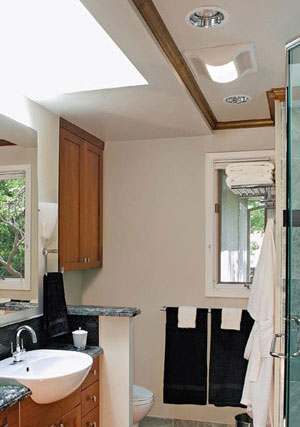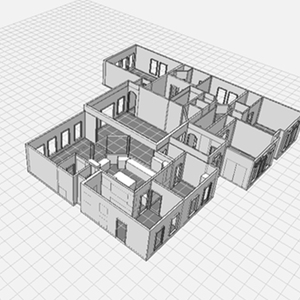A Buyer's Guide to Bath Fans
Today’s exhaust fans quietly mitigate moisture, promote health, and save energy with smart switches

My father was cheap, or maybe he was just ahead of his time. During the 1970s energy crisis, when my brothers and I were teenagers and liked to take 20-minute showers, he’d pound on the door and say, “Hot water doesn’t grow on trees. And turn on the fan in there,” knowing that when one of us finally emerged, a hot, foggy mist would billow out and make the hall’s walls glisten.
Then, 15 minutes later, he’d storm back upstairs, having heard the roar of the fan from the living room. He’d knock on the bedroom door this time, saying, “You left the fan on. Again.” Seems like he wanted it both ways.
And today he could have had it. While he would have choked on the current gas prices, my father would have loved the bathroom-ventilation systems now available. Quieter motors and a variety of controls—including timers, motion detectors, and humidity sensors—work together as a set-it-and-forget-it appliance that even a grungy teen can’t misuse.
Learn More:




Quiet-fan technology can improve your old fan, too
Roaring bathroom fans, like the one we could hear in our living room, are a thing of the past. Fan noise is measured in sones, an indication of perceived loudness. A 1-sone sound is likened to the sound made by a quiet refrigerator, while calm breathing is approximately 0.2 sones. The new fans from NuTone and Panasonic are in the 0.3 to 0.4 range. In general, bigger fans make more noise than smaller ones, and larger ducts make less wind noise than smaller ones. Blow through a straw, then blow through a toilet-paper roll, and it’s apparent.
Improvements in noise reduction have reached the upgrade market, too. If your fan makes a racket, several companies, including Broan, Fantech, and Continental Fan, sell quiet-fan retrofit kits that use existing housings and ductwork.
Smart features enhance performance
The important part of the fan is what’s behind the grille. Not surprisingly, bath-fan makers have jumped into the green scene and acquired Energy Star ratings for many models. Fan/light combos with compact-fluorescent bulbs are among the Energy Star offerings, although fans with electric-resistance heaters don’t make the grade.
Bathroom fans that are never turned on allow mold-in-ducing moisture to build up, and fans left on too long waste energy. Broan surmounts these problems with an adjustable behind-the-grille humidity sensor and timer that turn on the fan when moisture levels rise and shut it off after 5 to 60 minutes.
One of Panasonic’s WhisperGreen models has a built-in motion detector that keeps the fan going for 30 seconds to 60 minutes after it switches on. For better or worse, that means the fan turns on whenever someone enters the bathroom, whether to take a long, hot shower or just to get a Band-Aid from the medicine cabinet.
For bath fans without on-board sensors, many companies, including fan manufacturers and electrical suppliers, sell wall switches with programmable timers.
Smart Switches For fans without on-board sensors, switches with programmable timers are available. The Leviton 6260M timer switch can be set to keep the fan on for 10, 20, 30, or 60 minutes and costs about $25. The Lutron MA-l3T251-WH is a combination dimmer/timer switch that can be adjusted for a 5- to 60-minute fan run-time; it costs about $55. Flip the Marktime 42507’s switch to the on position, and both the fan and the light will come on. flip it down to the timer position, and the light will go off, but the fan will stay on to the user-set time of up to 60 minutes. The switch costs about $35).


Inline fans can serve multiple bathrooms
Because hot, moist air rises, it’s best to install a fan directly over the moisture source. That would be in a shower stall or over a tub. But what if there are multiple moisture sources in the bath? That’s where inline fans come in. An inline fan, which locates the fan assembly in an attic or a crawlspace, can serve multiple grilles in a large bath that has several moisture-producing fixtures. It can also be hooked up to ventilate several bathrooms.
A past disadvantage of multibath inline systems was that when the switch was turned on in one room, all the rooms were ventilated. Today, the American Aldes VentZone system can ventilate up to eight bathrooms individually. Ceiling grilles have a damper that opens when called upon by any switch, timer, dehumidistat, or occupancy sensor.
Architects and designers like multibath inline fans for aesthetic reasons. In contrast to the large plastic rectangle overhead that’s common to ceiling-insert fans, inline-fan grilles are discreet. Also, multiroom inline-fan systems require only one exterior vent, which keeps a roof plane cleaner-looking and more weathertight by reducing the number of penetrations.
Bath-fan installation tips
In spite of good intentions, bath-fan installations can go awry due to faulty planning or bad detailing. A friend once asked me what I thought was causing the black mold on his bathroom ceiling. When we crawled up into the attic and peeled back the fiberglass insulation over the bath fan, we saw that the duct had been poorly secured to the exhaust port and had come loose. A condensation puddle spread across the ceiling, feeding the mold. To help you avoid mistakes like this, we’ve gathered a list of tips from bath-fan installers.
• Use duct mastic or foil tape to secure duct connections. Despite its name, don’t use duct tape. It deteriorates over time.
• Insulate any fan ductwork that goes into an unheated attic. Otherwise, you risk water dripping out of the ceiling vent as hot, moist air from the shower condenses in the cold
• Increase the diameter of the ducts to reduce the resistance from a long duct run.
• Make sure any roof or sidewall wall vent has a screen to keep out critters. Also, if the dryer duct and the bathfan duct look similar, prominently mark which is which. You don’t want a screened dryer vent plugging up with lint and starting a fire.
• Ventilate all bath fans outside the house. Don’t dump them into the attic, basement, or garage. This might seem obvious, but it happens all the time.
• Don’t choose a fan that’s too powerful, or you’ll risk pulling all the air-conditioned or heated air out of the house.
• Check that the bathroom door has at least a 3⁄4-in. clearance above the finished floor to allow proper entry of makeup air, as recommended by the Home Ventilating Institute (HVI). Insufficient makeup air can diminish a fan’s air-moving capacity.
• Do not connect multibath inline fans with a three-way switch, which would allow someone to turn off the fan in another bathroom.
• Connect a fan over a tub or shower to a branch circuit protected by a ground-fault circuit interrupter (GFCI).
• Don’t exhaust a bath fan near a vented soffit, or next to a window or skylight, which can draw the moist air the fan has evacuated right back into the house. Roof vents are a better option, but require diligent flashing and waterproofing.
• Consider a sidewall vent (away from a window). This might be the best option because it allows the ductwork to be sloped downward, directing potential condensation out of the building.
Choosing the right fan is not exactly cut-and-dried

The Home Ventilating Institute (HVI) standardizes performance ratings for, among other products, bathroom fans. It also establishes guidelines for ventilation requirements, expressed as air changes per hour (ach), of different rooms in a house. bathrooms require 8 ach. At the risk of acronym overload, you should know that the amount of air a fan can move is expressed in cubic feet per minute, or cfm.
HVI bath-fan sizing guidelines say that a fan should pull 1 cfm for every square foot of floor space in bathrooms up to 100 sq. ft. Above that, HVI recommends a ventilation rate based on the number and type of fixtures. For a toilet, shower, and tub, add 50 cfm each. For a jetted tub, add 100 cfm. In this example, you would need a 250-cfm fan.
That all sounds pretty straightforward, but these are under ideal, laboratory-grade conditions, which means the fan is hooked up to a short length of smooth-wall duct. In the real world, where ducts snake around obstacles and change material on their way to a distant roof cap, it gets more complicated. Static pressure, a measure of air resistance, comes into play, reducing a fan’s cfm rating. As shown in the chart (courtesy of Panasonic), just one 4-in.-dia. adjustable elbow has the equivalent resistance of 15 ft. of smooth metal duct. A roof cap is equivalent to 30 ft. of smooth duct. And if you use insulated flex duct, you have to multiply its length by 1.5 to find the smooth-duct-length equivalent.
Sizing a fan, then, can be more complex than relying on HVI’s recommendation of figuring 1 cfm per sq. ft. of floor area. And the seemingly simple solution of just buying a bigger fan than what the floor-area calculations indicate you need has its own pitfalls. Exhausting more air from a room than necessary sucks expensive conditioned air from your home and can pull in unconditioned air. In a relatively tight house, a fan that’s too big can create negative pressure and suck flue gases from the chimney of the furnace or gas-fired water heater into the home. Bottom line: If you have a complex duct run, consult a professional at a plumbing-supply house to determine the correct size of the fan you need.
A new role for bathroom fans
The once-lowly bath fan’s job of removing odors and moisture has been elevated to a major role in whole-house ventilation. Some state codes—Minnesota’s, for example—now require a mechanical whole-house ventilation system. When a building is remarkably free of air leaks and drafts, the indoor-air quality can, well, stink, and dangerous levels of carbon monoxide and other pollutants can accumulate.
Some inline- and ceiling-insert fans can play a part in an engineered whole-house ventilation system. One requirement for whole-house ventilation is that the fan has a constant-use rating, meaning it can be powered on all the time. Panasonic’s WhisperGreen fans are designed to run constantly at a level of 30 cfm to 70 cfm as part of a whole-house ventilation system, and then kick up to a higher level when called upon.
Fine Homebuilding Recommended Products
Fine Homebuilding receives a commission for items purchased through links on this site, including Amazon Associates and other affiliate advertising programs.

Not So Big House

Graphic Guide to Frame Construction

Musings of an Energy Nerd: Toward an Energy-Efficient Home

























